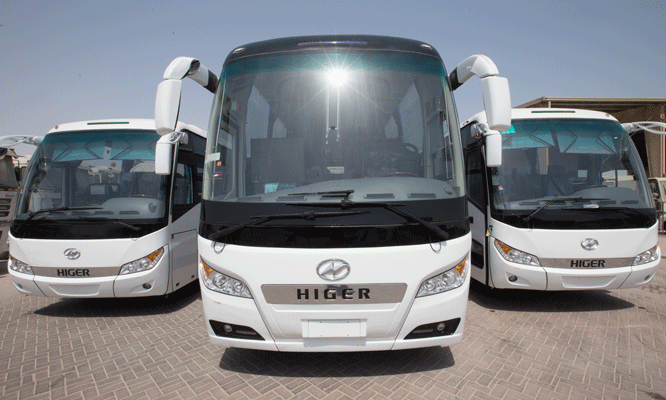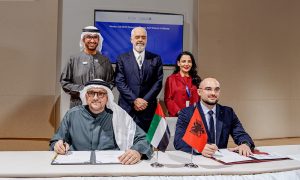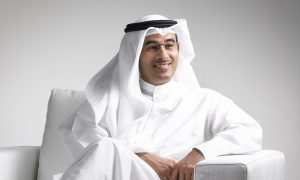Gulf bus sector on the move
Manufacturers are working to cater to different industry segments

In January, Dubai’s Roads and Transport Authority (RTA) reported that public transport in the emirate was used more than half a billion times in 2014, up considerably from the previous year. By 2020, the RTA hopes public transport will make up 20% of all journeys made in the emirate.
As an emphasis on sustainability slowly but steadily gains traction around the GCC, governments are seeing the value in upgrading their public transport infrastructure to more efficiently serve the needs of a growing population. Simultaneously, as other industries like education and tourism see growth, there also arises the need for transport options to ferry people around.
This creates a valuable opportunity for commercial vehicle manufacturers in the region to supply both government and private sector entities with buses and coaches. Truck & Fleet ME, therefore, decided to speak with manufacturers to glean some insight into their offerings for different industry segments and their plans to tap into the lucrative Gulf market.
Public transport
The public transport sector in the GCC and wider Middle East is expected to get a boost in coming years as governments place large orders for buses, in efforts to boost transport infrastructure.
Volvo Buses, for one, is seeing increased opportunities in the segment as attitudes towards public transport change in an oil-rich region, explains Steve Hedouin, vice president, Volvo Bus Corporation Middle East and Africa. The manufacturer delivered 55 coaches to Dubai’s RTA, as well as a batch of 18 B11R coaches to Sharjah. In Egypt, it has been awarded a tender for 150 city buses for the city of Alexandria, he says.
READ MORE from Truck & Fleet ME
“In the GCC, there is a change in mind-set and there is a greater need for transportation. The cities are booming, and they’re increasing in terms of size. Of course, oil is very cheap, but it still seems that the governments are paying more and more attention to fuel efficiency and pollution.”
This is bound to create a growing demand not just for more buses, but also buses that run cleaner and meet increasingly stringent emission requirements, he points out.
In terms of product segment, Volvo Buses offers a range of coaches and city buses for the Middle East. “For city bus applications, we use three types of chassis. The first one is the B7, which is a low-entry, high-floor city bus. We also offer the B7R, which is used in some countries as a city bus,” Hedouin says.
“The second one is the B9, which is offered as a low-floor bus. The third type of vehicle we’re offering is called B12MA, equipped with a 12.0L engine. The engine is located in the middle of the chassis and it’s an articulated, high-floor bus.”
High-floor city buses tend to be cheaper than their low-floor counterparts and are the more popular option with governments running on tighter budgets, Hedouin notes. “In the bus business, if you use a high-floor bus, the cost is usually much more affordable compared to low-entry and low-floor. It’s because the design of the chassis is much simpler, there is less engineering, less complicated parts.”
Countries like Egypt which tend to be more price-conscious thus usually opt for high-floor buses for their public transportation needs, he says.
School transport
Apart from the public transport sector, an important market segment that contributes to a large share of the demand for buses is school transport. As this is historically a very price-conscious segment in the GCC region, however, European manufacturers typically don’t supply vehicles to it.
READ MORE from Truck & Fleet ME
Chinese brands, on the other hand, are growing increasingly popular in the segment, as their perception in the market steadily improves, says Nihad Alkilani, general manager – Fleet & Commercial at Liberty Automobiles Company, the UAE dealer for Foton trucks and buses.
“In the earlier days, from about 2002 onwards, the market started to accept Chinese buses and coaches due to the cost factor only. European brands completely dominated the market, but since the cost was not feasible for operators, they started accepting Chinese brands.
“In the following years, however, Chinese buses underwent significant improvements. Now they sometimes exceed their European counterparts in some areas, and generally they compete very well.”
Many Chinese buses have been successfully running in the market without any issues, and customers have started to see the value in the products, he points out. Foton buses were introduced into the market by Liberty Automobiles about two years ago, and the dealer plans to relaunch the buses with more high-end specifications to suit the needs of the UAE market.
The school sector has been particularly lucrative for the brand, and the company supplies buses to institutions like the International School of Choueifat. Currently, Foton buses are offered with different seating capacities, ranging from 35 to 65 seats.
Meanwhile, KHF Automotive, the distributor of China’s Higer buses, is also working on expanding its footprint in the school sector. Safety is a top priority in school buses, and Higer buses come equipped with several features to make them safer, says Reju Joseph, sales manager at the firm.
“We mainly focus on safety. Our vehicles come with three-point seatbelts and a reverse camera, which gives an added advantage to the drivers. Now the school buses come with eight cameras: reverse camera plus the side cameras, and an inside camera.”
Higer buses can also be fitted with GPS tracking, he notes. Additionally, the vehicles come with a fire-suppression system inside the engine compartment which is automatically activated in the event of a fire in the compartment. Other safety features include breakable windows and a slip-resistant floor.
When asked what school customers typically look for besides safety features, Alkilani notes that they also seek buses that can accommodate the maximum number of students at a reasonable cost. Earlier, many schools depended on buses from Japanese competitor brands, which had an average seating capacity of 30 seats and came equipped with foldable jump seats. But Dubai’s RTA now stipulates that jump seats are no longer allowed on school buses due to safety concerns, further diminishing seating capacity on the Japanese buses.
Foton buses, however, come with 35 complete seats, including seats for a driver and a guide, bringing total capacity to 37. Furthermore, they are specifically manufactured for school transport purposes, as opposed to buses from other brands, which are modified in garages to fit RTA specifications for school buses, Alkilani says.
Tourism
Another industry with immense potential for commercial vehicle manufacturers in the region is tourism, as various Gulf countries look to ramp up offerings in the sector.
Buses and coaches sold to the tourism sector are generally of the luxury variety, and come with a host of different features for passenger comfort and entertainment, Alkilani says. Foton buses and coaches supplied to the tourism sector are equipped with an on-board refrigerator, LCD TVs and electric chargers for mobile phones, laptops and cameras, for instance. Liberty Automobiles supplies Foton buses to different tour operators in the country, such as Arabian Incentives.
READ MORE from Truck & Fleet ME
Meanwhile, Higer’s H92K 53-seater, launched in the UAE market last year, has been faring well in the tourism segment, Joseph says. The 12m bus comes with two doors and is equipped with features such as on-board TVs, reclining seats, refrigerator and luggage compartment.
“We have buses travelling from here to Salalah every day, a distance of around 1,350km,” Joseph says. He adds that the total industry volume annually in the UAE is 300-350 vehicles in the luxury coach segment, of which Higer has a 25-30% market share, selling between 85 and 100 vehicles every year.
Although Higer buses are more expensive than their other Chinese counterparts, they are more reliable due to the extensive use of European parts, he adds. The H92K is equipped with a 340hp Cummins Euro 3 engine, a Sachs Diaphragm spring clutch and ZF gearbox, and power steering.
Volvo Buses is also active in the tourism sector, and the manufacturer recently delivered 25 double-decker open-top buses to the UAE, built by Spanish bodybuilder Unvi on a B7RLE chassis.
“Unvi is a preferred bodybuilder for double-deckers open-top for Volvo worldwide, and therefore we send the naked chassis to Spain. They build the body in Spain in their own factory, and then we ship the complete vehicles to the final customer,” Hedouin says.
The tourism industry holds promise for the Swedish automaker in the UAE and the wider region in the near future, he notes. “The tourism segment is expanding. Of course, it has its ups and downs, but there is potential for this industry to grow in the Middle East.”
“More and more people are coming to the UAE on vacation, so tourism will definitely increase. And tourism means people will need to move from hotels to attractions, so that’s why the coach segment is also a segment where we see more and more interest.”
Hybrid buses: the way forward for the GCC?
In July, Volvo Buses announced that it was “actively looking at opportunities” to bring its energy-saving electric buses to the Middle East. The manufacturer had recently introduced its concept electric bus in Gothenberg, and is currently gearing up for production of all-electric vehicles in 2017.
Volvo Buses already has a range of electrified buses, such as the Volvo 7900 Hybrid – with over 2000 units sold – and the Volvo 7900 Electric Hybrid. As GCC countries make conscious efforts to promote sustainability, it’s worth examining whether more eco-friendly public transport options are viable in the region.
While hybrid buses have been successful in Western countries on account of the high fuel costs there, they have naturally not been a popular option in an oil-rich region like the GCC, Hedouin notes. “In the GCC countries, due to the cost of oil, we’re still not there yet. However, there are a couple of cities and countries that are extremely interested in such products, because there is a big change in mind-set, leaning towards less pollution.”
Although hybrid buses are certainly a cleaner alternative to conventional buses, the high temperatures in the region present their own set of challenges. “Temperatures are usually above 45 degrees in all Gulf countries and it’s a trade-off when it comes to fuel consumption. Air conditioning in the GCC accounts for more than 50% of the fuel consumption, especially if you have a lot of stop-and-go, such as in city applications,” Hedouin points out.
“So if you need high-performing air conditioning, the demand on electricity to supply this air conditioning unit will be extremely high. Therefore, the performance of your vehicle in terms of fuel efficiency will decrease.”
To counter this, Volvo Buses is currently looking at how to strike a balance between fuel efficiency and air conditioning performance in its vehicles. However, Hedouin notes that Volvo hybrid diesel buses have been running without issues in Spain, where temperatures can reach 35 degrees Celsius in summer. “I’m sure that the Middle East will also soon see such products in operation.”
READ MORE from Truck & Fleet ME
























